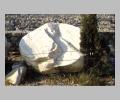| Context: | Athens |
| Type: | Temple |
| Summary: | Peripteral temple; slightly south and east of the center of the Acropolis. |
| Date: | ca. 447 BC - 432 BC |
| Dimensions: | Stylobate: 30.88 m x 69.50 m; axial spacing external columns: 4.29 m fronts (3.68 m corners) and 4.29 m flanks (3.69 m corners); lower diameter exterior columns: 1.91 m (1.95 m corners); height exterior columns: 10.43 m; height entablature: 3.30 m. |
| Region: | Attica |
| Period: | Classical |
Plan:
Doric peripteral temple, 8 x 17 columns. Double cella with pronaos and opisthodomos, both with 6 prostyle columns. The smaller west cella had 4 interior columns. Inside the east cella was a U-shaped colonnade of 9 columns and a pier on each long side, and 3 columns between the 2 piers on the short side. (Travlos reconstructs columns in place of the piers.) Toward the west end of the interior colonnade was a statue base for the cult statue of Athena Parthenos with a large shallow rectangle cut to create a reflecting pool in front of it. Bronze doors are postulated for both eastern and western cellas.
History:
This temple replaced an earlier temple in the same location, the Pre-Parthenon, built before the Persian War and destroyed by the Persians in 480/79 B.C. The Parthenon was created by Iktinos, Kallikrates and Pheidias. The eastern cella was dedicated to Athena Polias (Dinsmoor says it was known as the Neos Hekatompedos, or cella of 100 feet) and the western cella was dedicated to Athena Parthenos, "the Virgin," from which the whole building became known as the Parthenon. It is likely that the doors of the western cella were strengthened with bronze bars and that the western cella was used as a treasury. The eastern doors were probably hollow bronze. Lawrence differs with Stevens on the reconstruction of all the doors in that Steven's doors have rectangular grilled areas above the lintels to reduce weight and to allow light to enter the sanctuaries. The Classical Parthenon seems to have been damaged by fire but the exact date of the fire and subsequent repairs is debated, with suggestions ranging from 150 B.C. to 267 A.D. (during the invasion of the Herulians). In any case, repairs included the exact reconstruction of the colonnade of the eastern cella, a new statue base and repairs to the capitals on the columns of the western porch. The Parthenon was converted to a Christian church ca. 600 A.D., and in 1687 a small mosque was built in the cella.
Other Bibliography:
See Also:





